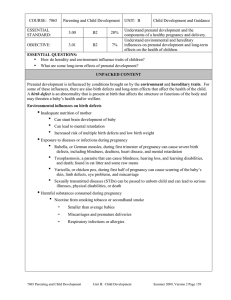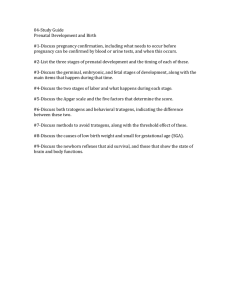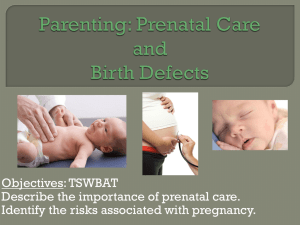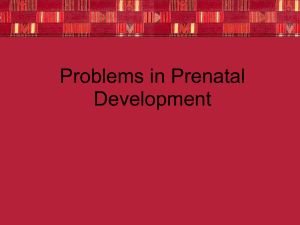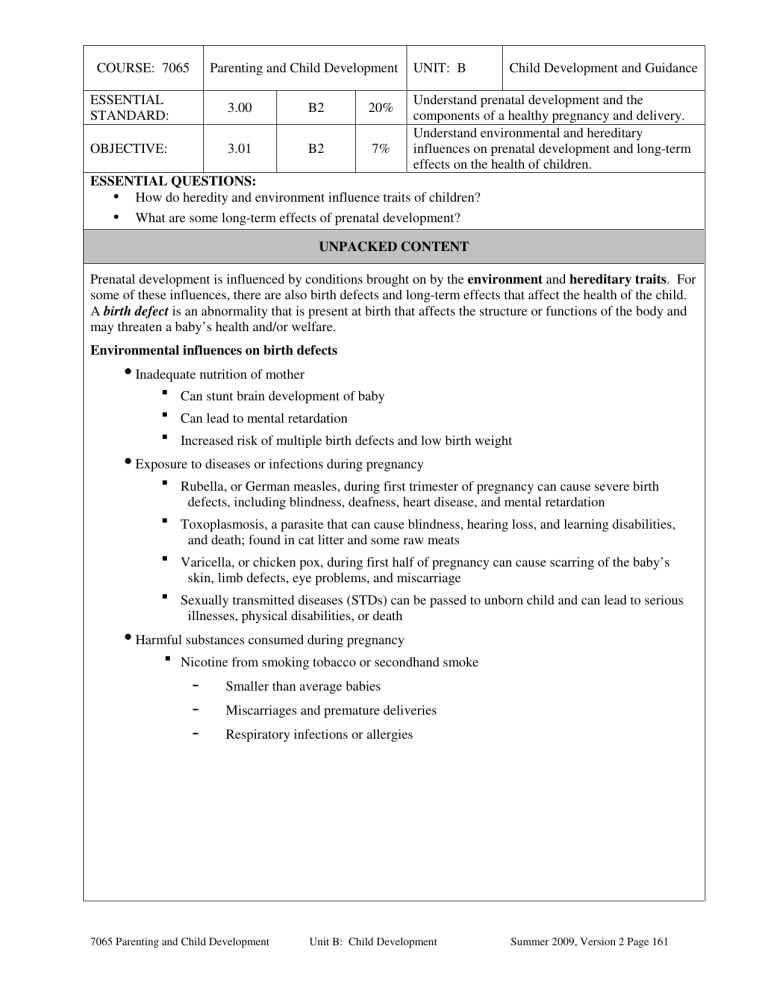
COURSE: 7065 Parenting and Child Development ESSENTIAL STANDARD: 3.00 B2 20% OBJECTIVE: 3.01 B2 7% UNIT: B Child Development and Guidance Understand prenatal development and the components of a healthy pregnancy and delivery. Understand environmental and hereditary influences on prenatal development and long-term effects on the health of children. ESSENTIAL QUESTIONS: How do heredity and environment influence traits of children? What are some long-term effects of prenatal development? UNPACKED CONTENT Prenatal development is influenced by conditions brought on by the environment and hereditary traits. For some of these influences, there are also birth defects and long-term effects that affect the health of the child. A birth defect is an abnormality that is present at birth that affects the structure or functions of the body and may threaten a baby’s health and/or welfare. Environmental influences on birth defects • Inadequate nutrition of mother Can stunt brain development of baby Can lead to mental retardation Increased risk of multiple birth defects and low birth weight • Exposure to diseases or infections during pregnancy Rubella, or German measles, during first trimester of pregnancy can cause severe birth defects, including blindness, deafness, heart disease, and mental retardation Toxoplasmosis, a parasite that can cause blindness, hearing loss, and learning disabilities, and death; found in cat litter and some raw meats Varicella, or chicken pox, during first half of pregnancy can cause scarring of the baby’s skin, limb defects, eye problems, and miscarriage Sexually transmitted diseases (STDs) can be passed to unborn child and can lead to serious illnesses, physical disabilities, or death • Harmful substances consumed during pregnancy Nicotine from smoking tobacco or secondhand smoke - Smaller than average babies - Miscarriages and premature deliveries - Respiratory infections or allergies 7065 Parenting and Child Development Unit B: Child Development Summer 2009, Version 2 Page 161 OBJECTIVE: 3.01 B2 7% Understand environmental and hereditary influences on prenatal development and long-term effects on the health of children. UNPACKED CONTENT Alcohol can cause fetal alcohol syndrome (FAS) - 20% of infants die - Facial deformities, delayed physical growth, heart defects, and hyperactivity - Mental retardation or disabilities - Poor coordination - Difficulty controlling behavior Environmental influences on birth defects, continued • Harmful substances consumed during pregnancy, continued Drugs, over-the-counter and illegal - Even over-the-counter drugs can potentially cause serious defects if taken during pregnancy; nothing should be taken during pregnancy without doctor’s permission - Pass on drug addiction to the baby; makes it necessary for baby to go through painful withdrawal period after birth - Produces severe, long-term learning and behavioral problems - Cocaine increases risk of miscarriage; produces strokes that lead to brain damage, heart attack, birth abnormalities, or death; causes tremors, irritability, sleep problems, and developmental delays - Ecstasy leads to congenital heart problems, physical abnormalities Large amounts of caffeine increase risk of miscarriage, low birth-weight babies, and infant death • Exposure to hazards during pregnancy Chemicals--- some types of paint, pesticides, lead-based chemicals, carbon monoxide, mercury, solvents, paint thinners, and formaldehyde---can potentially cause physical and mental abnormalities in unborn baby X rays can cause childhood cancer, miscarriages, and mental retardation Toxoplasmosis – extreme high blood pressure • Accidental injuries Cerebral palsy caused by damage to the brain before, during, or shortly after birth Damage to the developing embryo and fetus from accidental injuries of all types can potentially cause a wide range of birth defects 7065 Parenting and Child Development Unit B: Child Development Summer 2009, Version 2 Page 162 OBJECTIVE: 3.01 B2 7% Understand environmental and hereditary influences on prenatal development and long-term effects on the health of children. UNPACKED CONTENT Hereditary influences on prenatal development and birth defects • Dominant genes are stronger; recessive are weaker • Defective recessive genes inherited from both parents Cystic fibrosis---caused by inheritance of recessive genes; more likely to affect Caucasians than African- or Asian-Americas Tay-Sachs disease--- an inherited disease most common among eastern European families of Jewish descent Sickle cell anemia--- Malformed red blood cells that deprive the body of oxygen and prevalent in African-Americans • Defective dominant gene inherited from one parent Hemophilia---passed on from mothers to sons only; prevents blood from clotting Huntington’s disease---manifests in adulthood, leads to dementia Duchenne muscular dystrophy---transmitted by female carriers, usually affects only males Color blindness---usually affects only males • Errors in chromosomes---problems with the number or structure of chromosomes Down syndrome---associated with mental retardation, increased risk of heart defects, leukemia, poor muscle tone, and distinctive physical characteristics Combined influence of heredity and environment on prenatal development and birth defects • Inherited tendency to develop heart defect combined with drug use or virus during pregnancy causes child to have heart defect • Cleft lip/cleft palate---gap in upper lip or palate; caused by heredity or environment or both • Spina bifida and hydrocephalus caused by both hereditary and environmental factors; risk can be reduced by taking folic acid during pregnancy • Multiple births The hyper-ovulation gene may be inherited from the mother; leading to fraternal twins Primarily influenced by environment---Twin-to-twin syndrome (TTTS) is the result of one twin taking nourishment from the other; fertility drugs 7065 Parenting and Child Development Unit B: Child Development Summer 2009, Version 2 Page 163
